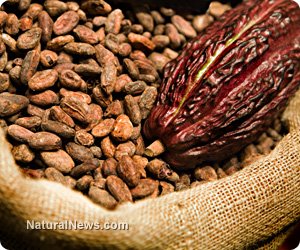- Newly released JFK files reveal Pentagon's role in creating Lyme disease and covid in the same lab
- DEADLY DECEPTION: How COVID vaccines increased mortality rates and why authorities hid the truth
- CDC finally halts $11 billion COVID funding scam as health officials admit the ‘pandemic’ was a fraud
- The hidden dangers in your kitchen: How cooking methods impact diabetes, cancer and aging
- GAIN-OF-FUNCTION CAT-BIRD-FLU now on the rise as nearly a dozen cats in Colorado "test positive" for Bird Flu due to contaminated cat food
- Trump's greatest betrayal so far: Accelerating Middle East wars, silencing dissent, and serving Zionist masters
- Here are TEN all-natural ways to protect your garden without using harmful chemicals
- Why you should think twice before buying mainstream toothpaste formulas
- ATTENTION PRESIDENT TRUMP: Please WITHDRAW your nomination of Dr. Susan Monarez for CDC Director as she is a VAX FANATIC and TOXIC JAB ZEALOT
- Was JFK's assassination orchestrated by a CIA double agent? New evidence points to James Angleton as the “architect”
- Ginseng's hidden anti-aging power: How compound K is rewriting the rules of skincare
- Home gardening for preppers: A beginner's guide to growing your own food
- “Endgame: The Hidden Agenda 21” unveils a world of conspiracy and control
- Paper or plastic? The environmental deception behind bag bans
- Record honeybee deaths devastate U.S. agriculture, pesticides under scrutiny
- Senate Democrats deny censorship industrial complex existed, defend government's role in silencing dissent
- Lab leak confirmed? Boris Johnson's stunning reversal on COVID origins sparks global debate
- Speaker Johnson warns Congress may defund or disband rogue courts targeting Trump
- Newly released JFK files reveal Pentagon's role in creating Lyme disease and covid in the same lab
- Elon Musk: Aliens could be here on Earth RIGHT NOW
- Festive flavors: The sweet history, nutritional profile and health benefits of pecan pie
- Trump reverses course on Gaza plan, says “nobody is expelling Palestinians”
- Reclaim your health: How midlife exercise reverses years of inactivity
- Big Pharma's $8 Billion bribery scheme exposed: how doctors are pushed to prescribe junk science, not heal
- Boys are back in town: Trump’s patriotic alpha crew takes the wheel while toxic females ride in the backseat
- EPA advisor admits the agency is funneling billions to climate groups ahead of Trump’s return to White House
- Space war brewing? Russia threatens to destroy Starlink satellites
- Survival 101: Effective EMF blocking techniques
- A lack of integrity in Academia: Harvard professor found GUILTY of fraudulent research to promote CRT theory
- Mike Adams Sermon 66: God will DESTROY ISRAEL for its wickedness
- 5 Simple steps to boost your brainpower: How to strengthen executive function in a distracted world
- Rep. Nancy Mace introduces bill to ban biological males from female facilities on federal property
- Sugarcane extract superior to cholesterol-lowering drugs?
- WHO focusing more on policing speech about public health and implementing global surveillance systems
- Pilots report mysterious lights 'moving at extreme speeds' across Oregon skies
- Dr. Mike Yeadon releases 15-minute testimony - WATCH - about genocidal intent of COVID “vaccines”
- EPA advisor admits the agency is funneling billions to climate groups ahead of Trump’s return to White House
- The Health Ranger releases “Vaccine Zombie” song and music video, using AI-animated zombies for the music video
- California's social media censorship law struck down: A victory for free speech or a threat to online safety?
- Dr. Mike Yeadon releases 15-minute testimony - WATCH - about genocidal intent of COVID “vaccines”
- The pandemic as a tool for INDOCTRINATION: Understanding “The Indoctrinated Brain” by Dr. Michael Nehls
- Florida takes a stand: DeSantis proposes permanent ban on mRNA vaccine mandates
- Mike Adams releases country western hit single: Goin’ Back in Time is Comin’ Home
- Mike Adams releases music poetry sensation: A Child of God
- “Why we influenced the 2020 elections”: Facebook files reveal the coordinated effort to bury the Hunter Biden laptop story
- RFK Jr. clears key hurdle: Sen. Susan Collins backs controversial HHS nominee, signaling a new era for health policy
- Unpacking the Lies That We’ve Been Fed – new song and music video released by Mike Adams, the Health Ranger
- Mike Adams releases new song and music video: Nothing More Disgusting Than a Globalist
- Newly released JFK files reveal Pentagon's role in creating Lyme disease and covid in the same lab
- Congratulations to the FULLY UNVACCINATED as you resisted the COVID-19 PROPAGANDA MACHINE fueled by over $100 BILLION
- Michigan sheriff announces criminal investigation into 2020 election crimes, Dominion Voting Systems
- Israeli soldiers accused of even more torture and abuse in the West Bank
- Migrants are taking advantage of recent hurricanes to scam residents and loot their homes
- House Intelligence Committee calls for the ARREST and PROSECUTION of Dr. Anthony Fauci
- Red Cross issues warning to stop blood plasma donations from vaccinated people
- Scientists confirm: GENIUS brain function can be spontaneously unleashed in humans without any apparent cause
- EPA advisor admits the agency is funneling billions to climate groups ahead of Trump’s return to White House
- HYSSOP: What research reveals about the health benefits of this ancient holy herb
- Two containers with completed ballots fall out of truck in Florida
- Fully vaccinated about to see “tsunami” of illness and death, warns virologist
- Global leaders unite to clamp down on “misinformation” with UN-backed Cascais Declaration
- BREAKING: 2025 NDAA authorizes mandatory military draft of WOMEN across America… as Pentagon pursues global NUCLEAR war with both Russia and China at the same time
- Michael Yon warns of a ZIONIST TAKEOVER in Trump’s second administration
- BOMBSHELL: DNA testing kits are a SCAM to develop ethnic-specific bioweapons
- Ozempic and Wegovy weight loss drugs are injectable LIZARD VENOM PEPTIDES that may unleash a devastating wave of organ failure… side effects align with symptoms of SNAKE BITES
- Israeli soldiers accused of even more torture and abuse in the West Bank
- These 13 countries just signed an agreement to engineer a global FAMINE by destroying food supply
- NASA admits that climate change occurs because of changes in Earth’s solar orbit, and NOT because of SUVs and fossil fuels
- RFK Jr. clears key hurdle: Sen. Susan Collins backs controversial HHS nominee, signaling a new era for health policy
- Sermon 30: How Jesus reveals Caesar’s FAKE CURRENCY and FALSE AUTHORITY
- Coriander seeds: Ancient medicine backed by modern science
- Arizona officials claim Maricopa County needs 10-13 days to tabulate results of the election
Native to the tropical regions of Mesoamerica, the evergreen cacao tree grows small, white flowers throughout the year, which are pollinated by tiny flies. The fruit, called a cacao pod, then grows. It is an oval shape, and changes from a yellowish color to more of an orange when ripe, and weighs about a pound. Each pod contains a white fruit with around 40-50 seeds, usually called beans. The white flesh is eaten or made into juice in some countries. The beans are the main ingredient for chocolate and cocoa powder. The fat from the seeds is the source of cocoa butter (http://en.wikipedia.org/wiki/Theobroma_cacao). The tree grows in river basins because it requires a humid climate with regular rainfall. It is an understory tree, doing best with overhead shade.
Organic, raw cacao is a superfood containing a variety of unique phytonutrients, including high amounts of sulfur, magnesium, and phenylethylamine. It increases focus and alertness while also keeping you happy. (http://www.rawcacao.com/)
Cacao has an ancient history
The indigenous peoples of Mesoamerica have enjoyed cacao since before the time of Christ. Used as a food, a medicine, and a currency, cacao has been cultivated throughout Mexico, Central America, and South America since the Early Formative Period (1900-900 BC). Cacao was so highly valued that the ancient native peoples celebrated it, immortalizing its place in their society through oral history, stonework, pottery, etc., chronicling its use in rituals and everyday life. Archaeological sites have found ceramic vessels with cacao residues from the pre-Olmec peoples, from several sites in Mexico and throughout Central America, dating from 1750-1900 BC.Cacao has been around so long that historians are not sure about the domestication and distribution of cacao. Hypotheses conflict as to whether it originated in the Amazon River Basin and was carried north, or if it originated in southern Mexico and was carried south. The first to grow the beans as a crop is believed to be the Olmec Indians, from 1500-400 BC. By 600 AD, Mayans had migrated to the northern regions of South America, and took cacao with them, establishing plantations. (http://en.wikipedia.org/wiki/Theobroma_cacao)
Cacao is part of the Mayan Creation Myth, and is believed to be of divine origin. Theobroma means Food of the Gods. The Mayans believe the Plumed Serpent gave cacao to them after humans were created from maize by the divine grandmother goddess, Xmucane. They still celebrate cacao and honor it with an annual festival in April. In a similar way, the Aztecs believe their god Quetzalcoatl discovered cacao. The consumption of cacao was restricted to the society's elite. (https://www.naturalnews.com/030603_cacao_medicine.html)
In the 1500s, explorers started encountering cacao as they made contact with indigenous peoples. Columbus was the first European to learn of cacao, when they captured a canoe in Guanaja that was carrying it as cargo. They sent samples back to King Ferdinand but cacao did not become popular in Europe at this time because Columbus was only aware of the currency use of cacao, not the food or medicinal use (http://www.phytochemicals.info/research/cacao-history.php). 20 years later, Cortez recorded its use in the court of Emperor Montezuma. A few decades later, Dominican friars took Mayan nobles to visit Prince Philip of Spain, and brought gifts of cocoa, mixed and ready to drink. Spain and Portugal did not export it to the rest of Europe for almost a century. It gained popularity as a medicine and aphrodisiac before regular shipments to Europe started. The first shop opened in London in 1657 with a price that made it a beverage for the elite. It was 25 years before it was prepared as a food. (http://inventors.about.com/od/foodrelatedinventions/a/chocolate.htm)
In the 1750s, a Swedish naturalist decided the word "cocoa" did not represent the substance well enough and renamed it "theobroma" - Greek for "food of the gods."
Chocolate was introduced to the United States by an Irish chocolate maker. He imported beans from the West Indies to Dorchester, Massachusetts with his partner, Dr. James Baker. Soon, America's first chocolate mill was making the famous Baker's chocolate. As demand grew, technology such as the cocoa press was invented to help keep up, slowly bringing the price down. (http://inventors.about.com/od/foodrelatedinventions/a/chocolate.htm)
The more refined chocolate has been made into various edibles to increase shelf life, to reduce cost, and to improve taste; less of the original cacao, and its more than 300 phytonutrients, is retained. Today, most Americans eat milk chocolate, which is refined cocoa with milk solids and sugar added; few have ever tasted the original, raw cacao of legend.
The health benefits of chocolate are numerous
Publications started appearing about the medicinal use of cacao around the 16th century. The Badianus Codex and the Florentine Codex, both from the 1500s, mention cacao uses ranging from reducing fatigue and fever to improving heart strength and breathlessness. Other historical manuscripts list additional uses such as treatment of kidney and bladder disease, dysentery, and liver weakness, and to increase appetite. It was thought to be nourishing, digestion improving, life lengthening, and health preserving. Leaves from the flower were used to treat skin problems such as burns, and stomach complaints. (http://www.phytochemicals.info/research/cacao-history.php)There are many species of Theobroma, with the most commonly cultivated species being Theobroma cacao, with two subspecies. It has protein, fat, carbohydrates, fiber, iron, zinc, copper, calcium, magnesium, and sulfur. Additional chemical constituents include antioxidants and the chemicals phenylethylamine and anandamide, all of which play a role in why chocolate makes us feel good. From quickening the pulse to effects on blood pressure and blood sugar that translate to excitement, consuming chocolate often creates feelings of elation.
The theobromine in chocolate affects our nervous system in a similar way to caffeine; dilating blood vessels and making some people feel hyper then lethargic. Dogs should not eat chocolate as they lack the enzymes to digest it. The small caffeine content and the oxalic acid also give some people pause. The caffeine amount is very low in dark chocolate; not really enough to worry about. The oxalic acid inhibits absorption of calcium, especially when combined with sugars. Small amounts of organic, raw cacao are a good source of antioxidants. The more processed the chocolate; the fewer antioxidant properties it retains. Additionally, chemicals are used in the processing of cacao unless it is certified organic. (https://www.naturalnews.com/022610_cacao_chocolate_raw.html)
For those new to cacao, there are many wonderful ideas and recipes online, some ancient, for making a nice morning beverage to replace your coffee. Most will probably be a bit surprised by the bitter taste, but try it again as you'll probably get used to it. Because of the richness of the phytochemicals, don't overdo it. Just a small handful of nibs or a few teaspoons of raw cacao powder is okay but too much more may cause a surprising effect on your nervous system.
Sources for this article include:
https://www.naturalnews.com/030603_cacao_medicine.html
http://en.wikipedia.org/wiki/Theobroma_cacao
http://www.rawcacao.com/
http://www.phytochemicals.info/research/cacao-history.php
http://inventors.about.com/od/foodrelatedinventions/a/chocolate.htm
https://www.naturalnews.com/022610_cacao_chocolate_raw.html
Cacao at FETCH.news
Get independent news alerts on natural cures, food lab tests, cannabis medicine, science, robotics, drones, privacy and more.
Take Action: Support Natural News by linking to this article from your website
Permalink to this article:
Embed article link: (copy HTML code below):
Reprinting this article:
Non-commercial use OK, cite NaturalNews.com with clickable link.
Follow Natural News on Facebook, Twitter, Google Plus, and Pinterest
Science News & Studies
Medicine News and Information
Food News & Studies
Health News & Studies
Herbs News & Information
Pollution News & Studies
Cancer News & Studies
Climate News & Studies
Survival News & Information
Gear News & Information
News covering technology, stocks, hackers, and more



"Big Tech and mainstream media are constantly trying to silence the independent voices that dare to bring you the truth about toxic food ingredients, dangerous medications and the failed, fraudulent science of the profit-driven medical establishment.
Email is one of the best ways to make sure you stay informed, without the censorship of the tech giants (Google, Apple, Facebook, Twitter, YouTube, etc.). Stay informed and you'll even likely learn information that may help save your own life."
–The Health Ranger, Mike Adams














































